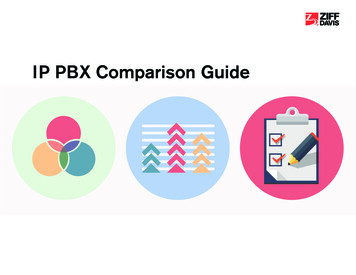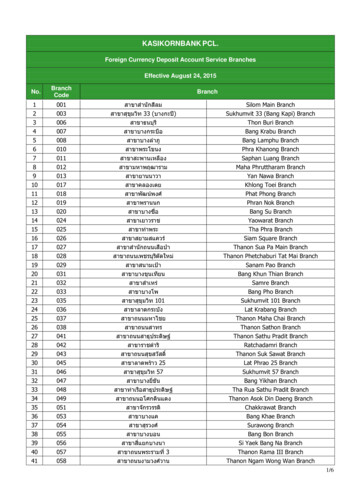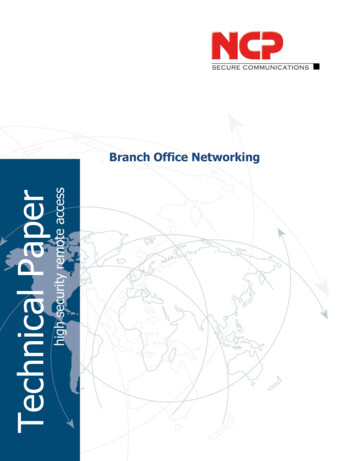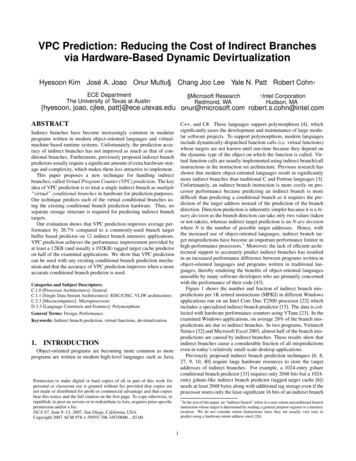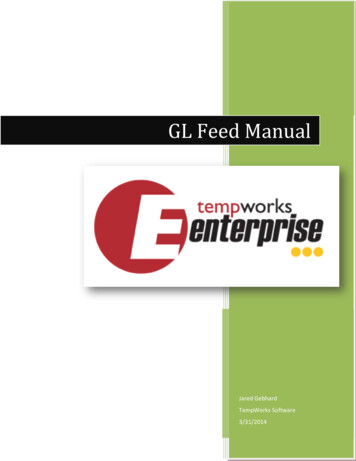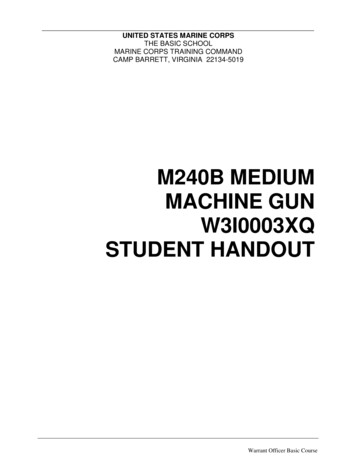
Transcription
Streamlined Medium Branch Network OverviewRevised: December 21, 2009This chapter describes the Streamlined Medium Branch Network design and components.Contents Introduction, page 1 Medium Branch Design Considerations, page 4 System Design, page 7 Topology, page 11 Cisco Platforms and Versions Evaluated, page 12 References and Recommended Reading, page 13IntroductionThe Streamlined Medium Branch Network enables enterprises with branch offices of 50 to 100 users todeploy high-value network services such as unified communication and application optimization on topof a secure branch network infrastructure that is connected to a campus or data center core (central site)over a variety of WAN technologies. The goal of the Streamlined Medium Branch Network is to makedeployment of these services fast, simple, and predictable.The Streamlined Medium Branch Network is one of the Cisco Integrated Services Networks for thebranch office. These networks focus on providing branch office deployment blueprints for connectivity,security, voice, and application optimization services integrated into the branch router. IntegratedServices Branch Networks consist of three Services Ready Branch Networks, two Streamlined BranchNetworks, and one Basic Branch Network, each corresponding to a different size branch office andbranch router platform, as shown in Figure 1.Streamlined Medium Branch Network System Assurance GuideOL-19090-011-1
Streamlined Medium Branch Network OverviewIntroductionFigure 1Integrated Services Branch NetworksLarge Branch Office(100-350 users)Medium Branch Office(50-150 users)HeadquartersServices Ready Branch Network(Cisco Small Branch Office(up to 25 eadquartersHeadquartersStreamlined Branch Network(Cisco rExternalswitchIPIP277136Basic Branch Network(Cisco 1900s)HeadquartersThe Integrated Services Branch Networks are implementations of the Cisco Enterprise BranchArchitecture framework and focus on networking services directly integrated into the branch officerouter. The Framework is one component in the overall Cisco Service Oriented Network Architecture(Cisco SONA), which provides guidelines for designing advanced network capabilities into enterpriseIT infrastructure. Leveraging elements of the Cisco Enterprise Branch Architecture Framework, theCisco Integrated Services Branch Networks incorporate networking infrastructure components and themost common integrated services found in a typical branch office, as shown in the red box in Figure 2.All Integrated Services Networks have undergone an intensive system assurance test program and willbe tested on an ongoing basis as individual components continue to evolve.Streamlined Medium Branch Network System Assurance Guide1-2OL-19090-01
Streamlined Medium Branch Network OverviewIntroductionCommon Integrated Services in Enterprise Branch NetworksInstant MessagingUnified MessagingMeetingPlaceIPCCRFIDVideo DeliveryApplication DeliveryApplication IntegrationNetwork VirtualizationVideo ServicesMobility ServicesManagementIntegrated ServicesBuilding BlockLayersApplicationNetworkingServicesFigure 2Voice ServicesOptimization ServicesSecurity ServicesNetwork sing270991NetworkedInfrastructureLayerCommon Branch Network ComponentsThis guide focuses on deployment of the Streamlined Medium Branch Network. It provides design,implementation, and testing guidelines for the following features for a medium branch network: WAN services LAN services Network fundamentals– IP routing and addressing– Quality of service (QoS)– High availability Security services– Infrastructure protection– Access control– Secure connectivity– Threat prevention, detection, and mitigation Network management Voice services– IP telephony with centralized call control– IP telephony with local call control– Traditional telephony and faxStreamlined Medium Branch Network System Assurance GuideOL-19090-011-3
Streamlined Medium Branch Network OverviewMedium Branch Design Considerations Optimization services– WAN optimization– Application optimizationThe blueprint begins with a list of design criteria for a secure medium branch office network optimizedfor unified communication and access to centrally hosted enterprise applications. The “System Design”section on page 7 describes the network topology and network services that address these design criteria.The “System Implementation” chapter provides a step-by-step implementation of the topology andconfiguration of each service. Finally, testing methodology for the system is provided along with testcases and test results in the “System Testing” chapter. The “References and Recommended Reading”section on page 13 lists additional detailed documents on the various technologies used in theStreamlined Medium Branch Network.For a list of tested platforms, interface cards, modules, and software versions, see the “Cisco Platformsand Versions Evaluated” section on page 12.Medium Branch Design ConsiderationsToday most enterprise resources are typically located at the corporate headquarters and accessed from abranch office over a private WAN. However, certain types of applications and services continue to bedeployed in the branch office. To support them, a branch network must meet additional requirementsbeyond basic connectivity. For the medium branch office, these requirements typically include highavailability, security, manageability, telephony, and application optimization. The Streamlined MediumBranch Foundation has been designed to meet such requirements. The following are its main designcriteria: Branch Network Components, page 4 WAN Services, page 5 LAN Services, page 5 Network Fundamentals, page 5 Security Services, page 6 Network Management, page 6 Voice Services, page 6 Optimization Services, page 7Branch Network Components 50 to 100 active users within the branch office Multiple integrated network services deployed in the branch router Converged data, voice, and video network Minimal carbon footprint Majority of corporate resources are centrally located Telephony that supports the following use cases:– Moderate call volume user– Heavy call volume user– Decision makerStreamlined Medium Branch Network System Assurance Guide1-4OL-19090-01
Streamlined Medium Branch Network OverviewMedium Branch Design Considerations– Video-conferencing user– Conference roomWAN Services Dedicated bandwidth ranging from 3 to 6 Mb/s to handle data, voice, and video traffic Gigabit Ethernet or multiple T1 dedicated lines to WAN service providers network Traditional Layer 2 private WAN with various encapsulation options to guarantee privacy andreliabilityorLayer 3 Multiprotocol Label Switching (MPLS) Virtual Private Network (VPN) for increasedflexibility and reduced bandwidth costorLayer 2 Ethernet or MPLS VPN for greater control and simplified connectivityLAN Services Hierarchical network design to simplify deployment, troubleshooting, and management Connectivity to branch devices at Fast Ethernet or Gigabit Ethernet speeds Near-wire-speed performance between all devices Networking device redundancy without traffic loops Power-over-Ethernet (PoE)Network Fundamentals High availability, rapid recovery, and disaster recovery– Prolonged uptime and availability, to keep the branch productive– Rapid recovery in case of non-redundant component failure– Automatic switchover to backup WAN link that has a minimum one-quarter of the bandwidthof the primary WAN link– Elimination of all single points of failure between all networking devices– Ability to restore service within 24 hours in the event of a disaster– Maximum use of backup, standby, and spare links and devices Quality of service (QoS)– Application-specific traffic prioritization both within the branch office and across the enterpriseWAN– Bandwidth management for WAN-based traffic– Provisions for IP telephony, business video, critical and bulk data applications– Provisions to mitigate denial of service (DoS) and worm attacks– Identification and classification of critical application flows for QoS IP routing and addressing– Routing within the enterprise and between the branch and the service provider network– Direct Internet access from the branch– Support for multicast applicationsStreamlined Medium Branch Network System Assurance GuideOL-19090-011-5
Streamlined Medium Branch Network OverviewMedium Branch Design Considerations– Translation of private addresses and ports in order to access the Internet– Dynamic allocation of IP addresses for end devicesSecurity Services Infrastructure protection– Physical securing of access to networking devices– Disabling of unused services that may be used to exploit the network– Authentication of routing protocol updates Access control– Authentication and authorization services for controlling access to network resources– Logging capabilities for auditing access to network devices and resources– Integration with global access management system to enforce access privileges Secure connectivity– Secure interoffice connectivity for full-mesh and hub-and-spoke WAN topologies– Secure access into the branch network for remote or home office workers– Voice, video, and data separation on the LAN– Separation of network management traffic– Access to the server in the branch by home office users Threat protection, detection, and mitigation– Blocking of unauthorized traffic from entering or leaving the branch– Access to servers in the branch by home office users– Verification of source addresses for incoming traffic– Identification and mitigation of common DoS attacks and worms– Prevention of malicious attacks on the branch office network from outside– Prevention of attacks and security breaches from within the branch officeNetwork Management Monitoring of networking services through a unified management console Analysis of IP services and generation of data needed for verification of service level agreements Ability to synchronize network time to accurately analyze network performance Traffic monitoring and accounting Common infrastructure for collecting and logging events generated by network devices Ability to automate initial software installation and configuration of all network devices Ability to automate reconfiguration of all network devicesVoice Services Ability to use IP-based and traditional analog telephones in the branch network Support for WAN-based (Toll Bypass), LAN-based (Private Exchange), and PSTN (Traditional)calling Ability to regulate quantity of calls placed over the WANStreamlined Medium Branch Network System Assurance Guide1-6OL-19090-01
Streamlined Medium Branch Network OverviewSystem Design Support for direct dial to extension, caller ID, and calling number identification Support for voice and video calls Local voice mail and auto attendant Ability to use traditional analog fax devices Support for conference calling Transcoding of various voice codecs Connectivity to emergency services Support for multiple dial peers and plans Music on hold for waiting callers Capacity to support:– 5:1 user-to-active call ratio– 4:1 WAN-to-PSTN call ratio– 4:1 WAN-to-LAN call ratio– 2 percent of calls to be video– 5 percent of calls to be conferencing calls– 10 percent of calls resulting in a transcoding session Survivable central-site call controlorLocal call controlOptimization Services Maximize WAN link bandwidth utilization and throughput Improve response time of typical enterprise client/server applicationsSystem DesignBranch network design varies greatly from one enterprise to another. Each design reflects the size,location, cost constraints, and business requirements of the corresponding branch office. However,regardless of the network architecture, a set of common branch networking elements provides: Network connectivity within the branch, to the Internet, and to the rest of the enterprise Security for data residing in the branch or crossing the network Unified network management and configuration Voice and fax services to support reliable, converged VoIP and POTS communication Response time or data throughput acceleration for centrally located enterprise applicationsTo help enterprises address these common connectivity, security, management, voice, and optimizationneeds, the Streamlined Medium Branch Network assembles the most important and common of theseelements in a single, rigorously tested design. The goals of this design are to provide assurance that thevarious features interoperate and to provide a starting point for customization. The design focuses onlyon the services that integrate directly into the branch office router. Alternative designs that featureexternal appliances and provide the same functionality as the Streamlined Medium Branch Network areequally viable.Streamlined Medium Branch Network System Assurance GuideOL-19090-011-7
Streamlined Medium Branch Network OverviewSystem DesignFor guidance on implementation of such designs, see the Cisco enterprise branch architecture 6/networking solutions program home.html.The following components and fundamental connectivity, security, and management services were testedin the Streamlined Medium Branch Network: Branch Network Components, page 8 WAN Services, page 8 LAN Services, page 9 Network Fundamentals, page 9 Security Services, page 9 Management Services, page 10 Voice Services, page 11 Optimization Services, page 11Branch Network Components Cisco 2951 and Cisco 2921 Integrated Services Routers (ISRs) Cisco Catalyst 3560 Switches Cisco Unified IP Phones 7942G, 7945G, 7961G, 7962G, 7965G, 7971G, and 7985G Cisco Unified IP Conference Station 7936WAN Services Dedicated leased lines through service provider network– Four T1 lines with Multilink Frame Relay (MLFR), Multilink Point-to-Point Protocol (MLPPP)encapsulation– Two T1 lines with Multilink Frame Relay, MLPPP encapsulation– Gigabit Ethernet line shaped to 6 Mb/s Virtual lines through service provider network provisioned at provider edge (PE) devices– Frame Relay serviceConnectivity to service provider’s PE deviceFour T1 lines with MLFR encapsulationTwo T1 lines with MLFR encapsulation– Layer 3 Virtual Private Network (L3VPN)Connectivity to service provider’s PE deviceFour T1 lines with MLPPP encapsulationTwo T1 lines with MLPPP encapsulation– Layer 2 Virtual Private Wire Service (VPWS)Connectivity to service provider’s PE device:Four T1 lines with MLPPP encapsulationTwo T1 lines with MLFR encapsulationStreamlined Medium Branch Network System Assurance Guide1-8OL-19090-01
Streamlined Medium Branch Network OverviewSystem DesignFour T1 lines with MLFR encapsulationGigabit Ethernet line shaped to 6 Mb/sLAN Services Access switches with EtherChannel configuration Power-over-Ethernet (PoE) Fast Ethernet and Gigabit Ethernet connectivityNetwork Fundamentals High availability, rapid recovery, and disaster recovery– Redundant edge routers and links among networking devices– Backup WAN link with Symmetric High-Speed Digital Subscriber Line (SHDSL)– Hot Standby Router Protocol (HSRP) for routers– EtherChannel configuration for switches– Routers and switches with modular, field-replaceable components IP addressing and routing– Network Address Translation (NAT)/Port Address Translation (PAT)– Open Shortest Path First (OSPF)– Enhanced Interior Gateway Routing Protocol (EIGRP)– Border Gateway Protocol (BGP)– Routing Information Protocol (RIP) Version 2– Dynamic Host Configuration Protocol (DHCP)– Multicast QoS– Hierarchical 8-class QoS Model using Low Latency Queuing (LLQ), Class-Based WeightedFair Queuing (CBWFQ), Weighted Random Early Detection (WRED), and DifferentiatedServices Code Point (DSCP)-WRED on the router– Policing of voice and video traffic on the egress WAN interface– Shaping on the egress WAN interface– Class of service (CoS) to DSCP mapping with Weighted Round Robin (WRR) queuing on LANswitches– DSCP re-marking on LAN switches– Rate policing on LAN switches– Congestion-only queuing on LAN switches– Network Based Application Recognition (NBAR)Security Services Infrastructure protection– Disabling of unused services– Console timeoutsStreamlined Medium Branch Network System Assurance GuideOL-19090-011-9
Streamlined Medium Branch Network OverviewSystem Design– Password protection– Secure Shell (SSH) access– Routing protocol security Access control– Authentication, Authorization, and Accounting (AAA) with RADIUS and TACACS – Syslog Secure connectivity– Encryption with 3 DES (Data Encryption Standard) and 256-bit Advanced Encryption Standard(AES)– Key exchange with Diffie-Hellman Group 2– Data integrity with Message Digest 5 (MD5) and Secure Hash Algorithm 1 (SHA-1)– Preshared key (PSK)– IP Security (IPsec) Dynamic Multipoint VPN (DMVPN)– IPsec Group Encrypted Transport VPN (GETVPN)– 802.1Q virtual LANs (VLANs)– WebVPN (SSL VPN) Threat Protection, Detection, and Mitigation– Cisco IOS Intrusion Prevention System (IPS) with advanced signature set– Zone-based Cisco IOS firewall– 802.1x– Port security– IP source guard– PortFast bridge protocol data unit (BPDU) guard– DHCP snooping– Dynamic Address Resolution Protocol (ARP) inspection– Standard and extended Access Control Lists (ACLs)– Unicast Reverse Path Forwarding (uRPF)– DoS attack and worm detection and mitigation with NBARManagement Services Simple Network Management Protocol (SNMPv3) Cisco Configuration Professional (CCP) Network Time Protocol (NTP) IP service level agreements (SLAs) NetFlow version 5 Syslog Cisco Configuration EngineStreamlined Medium Branch Network System Assurance Guide1-10OL-19090-01
Streamlined Medium Branch Network OverviewTopologyVoice Services Cisco Unified Communications Manager (Cisco Unified CM) Survivable Remote Site Telephony (Cisco Unified SRST) Cisco Unified Communications Manager Express (Cisco Unified CME) Voice Gateway Cisco Unity Express Resource Reservation Protocol (RSVP) agent Digital trunk line for PSTN connectivity Analog device connectivity Emergency services Packet voice digital signal processing modules (PVDM) Fax pass-through Fax T.38 relay Transcoding Conferencing G.711 and G.729a codecs cRTP Music on hold (MOH)Optimization Services Cisco Wide Area Application Services (Cisco WAAS)TopologyThe Streamlined Medium Branch Network provides performance, availability, security, and networkmanageability for the medium branch, and integrates the various network services into the branch officerouter. As Figure 3 shows, it consists of dual Cisco 2900 series ISRs (either Cisco 2951 or Cisco 2921ISRs) for WAN termination and services aggregation, and an access layer with two Catalyst 3560switches for LAN connectivity. Access layer switches provide connectivity to end devices and providecontrol of access to the network. Redundancy and high availability are provided between all networkingdevices. This topology meets the criteria highlighted in the “Medium Branch Design Considerations”section on page 4.Streamlined Medium Branch Network System Assurance GuideOL-19090-011-11
Streamlined Medium Branch Network OverviewCisco Platforms and Versions EvaluatedFigure 3Streamlined Medium Branch Network ersIPIP274340AccessSwitchesCisco Platforms and Versions EvaluatedThe information in this document is based on the hardware and software listed in Table 1 and Table 2.Table 1Hardware ConfigurationsPlatformConfigurationCisco 2951EHWIC, 256MB flash , 512MB DRAMCisco IOS Release 15.0(1)M–AdvancedEnterprise Services ImageCisco 2921EHWIC, 256MB flash , 512MB DRAMCisco IOS Release 15.0(1)M–AdvancedEnterprise Services ImageCatalyst 3560WS-C3560G-48PS-SWS-C3560G-48TS-S128 MB DRAM, 32 MB flashCisco IOS Release 12.2(25)SEE4—IP ServicesImageStreamlined Medium Branch Network System Assurance Guide1-12OL-19090-01
Streamlined Medium Branch Network OverviewReferences and Recommended ReadingTable 2Hardware and Software 19Cisco Unified IP Phones 7942G, 7945G, 7961G,7962G, 7965G, 7971G, 7985G8.3.xCisco Unified Conference Station 79361.2(1)Cisco Unified Communications Manager Express 4.1(Cisco Unified CME)Cisco Unified Survivable Remote Site Telephony 4.1(Cisco Unified SRST)Cisco IOS Intrusion Prevention System(Cisco IOS IPS)5.0Cisco Configuration Engine3.0References and Recommended ReadingFor more information on topics described in this guide, see the following documents: Cisco WAFS Benchmark Tool for Microsoft Office Applications Installation and Configuration Note High Availability Campus Network Design—Routed Access Layer Using EIGRP or OSPF LAN Baseline Architecture Branch Office Network Reference Design Guide Enterprise QoS Solution Reference Network Design Guide Business Ready Teleworker Design Guide Enterprise Branch Security Design Guide Enhanced IP Resiliency Using Cisco Stateful Network Address Translation Stateful Failover for IPSecThe following information is referenced in this guide: Cisco Design Zone for Security Cisco IOS Configuration Fundamentals Command Reference Cisco IOS Debug Command Reference Cisco IOS IP Addressing Services Command Reference Cisco IOS IP Application Services Command Reference Cisco IOS IP Multicast Command Reference Cisco IOS IP Routing Protocols Command Reference Cisco IOS LAN Switching Command Reference Cisco IOS NetFlow Command Reference Cisco IOS Quality of Service Solutions Command Reference Cisco IOS Security Command ReferenceStreamlined Medium Branch Network System Assurance GuideOL-19090-011-13
Streamlined Medium Branch Network OverviewReferences and Recommended Reading Cisco IOS Voice Command Reference Cisco Solution Reference Network Design Guides Streamlined Medium Branch Network Quick Start Guide Support–Cisco SystemsStreamlined Medium Branch Network System Assurance Guide1-14OL-19090-01
Streamlined Medium Branch Network System Assurance Guide OL-19090-01 Figure 2 Common Integrated Services in Enterprise Branch Networks This guide focuses on deployment of the Streamlined Medium Branch Network. It provides design, implementation, and testing guidelines for the following features for a medium branch network: † WAN services .
